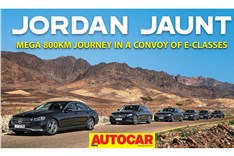2017 Mercedes-Benz E 220d review, road test
Far more affordable diesel E-class debuts Mercedes’ new 2.0-litre, four-cylinder engine in India.
Published on Jul 11, 2017 07:00:00 AM
22,028 Views
Follow us on



Steel springs give consistent body control but it’s still too big to be fun in bends.
The heart of the matter is clearly the engine. It’s a new modular unit (codename: OM654) with a displacement of 1,950cc across four cylinders and an all-aluminium construction. That means it weighs just 168kg – a full 35.4kg lighter than the outgoing 2.1-litre (OM651) motor, which Mercedes says, helps give it a 13 percent improvement in fuel economy. Other weight-saving measures include plastic engine mounts and a shift from a two-stage to a single-stage turbo. It’s paired to the venerable 9G-Tronic nine-speed automatic gearbox. The power output is 194hp (that equates to almost 100hp per litre), which is a fair bit more than the previous 220d engine’s 170hp, and the torque, at 400Nm, is exactly the same, albeit made 200rpm later at 1,600rpm.
Refinement is impressive. The old 2.1-litre engine was notorious ◊ ∆ for its clattery noise, whereas here there’s very little noise at low revs. When it does get audible at around 2,500rpm, it’s nowhere near as rough-sounding as before. The gearbox is, as ever, superb, using all of its nine ratios to great effect, so that you’re always in the meat of the powerband. Turbo lag feels all but non-existent, and there’s also very little of that gearbox lag you might feel on kickdown in other cars, as the 9G-Tronic will always have the right gear ready for you. It also does this smoothly and silently, with only a slight ‘kick’ felt, understandably, in Sport+ mode.
Some will remember that the outgoing four-cylinder diesel E-class was a higher-spec ‘250d’, while this one has been launched as a ‘220d’, and so yes, it makes 10hp and 100Nm less than the car it replaces. Enthusiasts will also, no doubt, miss that strong hit of power that you got with the old car, as this one – helped by the gearbox – feels a lot smoother and more linear across its rev band. Still, given the size of this car, its 0-100kph time of 8.81sec is not too shabby, and just about 1.8sec slower than the 350d. It does compare far more favourably in kickdown acceleration, however, taking 4.98sec and 6.52sec, respectively, from 20-80kph and 40-100kph. Drive modes, of course, make a difference, and, as with most luxury cars, we’d leave the Eco mode only for your chauffeur. Comfort is good for the city but can still feel a bit sluggish, so Sport might suit some drivers better. Sport+ is only for enthusiastic driving, more so because it keeps the engine on the boil, which feels a bit too high-strung for everyday use.
Copyright (c) Autocar India. All rights reserved.








Comments
Member Login
Personal Details
No comments yet. Be the first to comment.